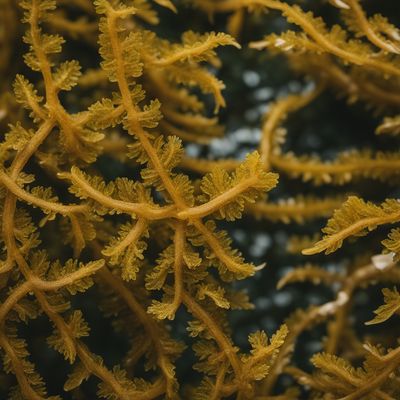
Ingredient
Sea spaghetti
The Ocean's Delicacy: Sea Spaghetti
Sea spaghetti is a brown seaweed that grows in the intertidal zone along rocky coastlines. It has long, spaghetti-like strands that can reach up to 2 meters in length. When cooked, sea spaghetti softens and develops a tender, slightly chewy texture. It has a mild briny flavor that pairs well with seafood, pasta, and salads. Sea spaghetti is commonly used in European cuisines, particularly in Ireland, France, and Spain.
Origins and history
Sea spaghetti has a long history of culinary use in coastal regions of Europe. It has been harvested for centuries and is highly valued for its unique taste and nutritional content. Sea spaghetti is rich in vitamins, minerals, and antioxidants, making it a nutritious addition to meals. It is sustainably harvested from the wild or cultivated in seaweed farms, ensuring its availability for future generations.
Nutritional information
Sea spaghetti is a low-calorie ingredient that is rich in iodine, calcium, and magnesium. It also contains vitamins A, C, and K, as well as antioxidants that promote overall health. However, individuals with iodine allergies or sensitivities should avoid consuming sea spaghetti.
Allergens
Iodine allergy
How to select
When selecting sea spaghetti, look for strands that are vibrant green or brown in color. Avoid seaweed that appears slimy, discolored, or has a strong odor. Opt for dried sea spaghetti, as it has a longer shelf life and can be rehydrated before use.
Storage recommendations
To store sea spaghetti, keep it in a cool, dry place away from direct sunlight. Store it in an airtight container to prevent moisture absorption. Properly stored, sea spaghetti can maintain its quality for several months.
How to produce
Sea spaghetti can be sustainably harvested from the wild or cultivated in seaweed farms. It requires clean seawater and suitable growing conditions. The seaweed is typically harvested by hand during low tide and then dried for storage and distribution.
Preparation tips
Before using sea spaghetti, rinse it thoroughly to remove any traces of sand or debris. It can be rehydrated by soaking it in cold water for about 10 minutes or until it becomes soft and pliable. Sea spaghetti can be used in salads, pasta dishes, stir-fries, or as a garnish for seafood. It pairs well with lemon, garlic, olive oil, and other ingredients that complement its mild briny flavor.
Substitutions
Wakame seaweed can be used as a substitute for sea spaghetti, offering a similar texture and taste. However, keep in mind that the flavor and appearance may differ slightly. If sea spaghetti is not available, it can be omitted from the recipe or replaced with other vegetables or seaweeds to add a different element to the dish.
Culinary uses
Sea spaghetti is commonly used in European cuisines, particularly in Ireland, France, and Spain. It is often added to seafood dishes, pasta, salads, and soups. In Ireland, it is traditionally used in dishes like carrageen pudding and seafood chowder. In France, it is used in salads and as a garnish for seafood platters. In Spain, it is incorporated into paella and other rice dishes.
Availability
Sea spaghetti is commonly found along the coastlines of Ireland, France, Spain, and other European countries. It is also available in specialty food stores and online retailers that offer seaweed products.



